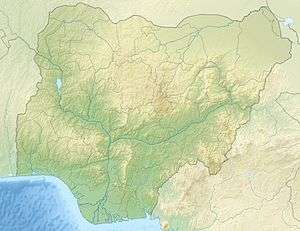Egbin Thermal Power Station
| Egbin Thermal Power Plant,Ijede | |
|---|---|
 Location of the Egbin Thermal Power Plant, Ijede
in Nigeria | |
| Country | Nigeria |
| Location | Egbin |
| Coordinates | 6°33′48″N 3°36′55″E / 6.56333°N 3.61528°ECoordinates: 6°33′48″N 3°36′55″E / 6.56333°N 3.61528°E |
| Status | Operational |
| Commission date |
Unit 1: May,1986 Unit 2: November,1985 Unit 3: May,1985 Unit 4:November,1986 Unit 5: May,1987 Unit 6: November,1987 |
| Thermal power station | |
| Primary fuel | Gas |
| Secondary fuel | Oil |
| Power generation | |
| Units operational | 6 x 220 MW |
| Make and model | Hitachi/Emerson |
| Nameplate capacity | 1,320 MW |
|
Egbin Thermal Power Plant, Ijede is the largest power plant in Nigeria and West Africa. | |
Egbin Power Plc is the largest power generating station in Nigeria with an installed capacity of 1,320 MW consisting of 6 Units of 220MW each. The station is located at Ijede / Egbin, in Ijede Town,[1] about 40 km north east of the city of Lagos in Ikorodu Local Government Area, it is situated on low land in Ijede and bounded by the Lagoon to the south, Agura/Gberigbe to the north and situated in Ijede Local Council Development Area.
The government acquired most of the land for the project by resettling the inhabitants to Ipakan. The first unit of the plant was commissioned in July 1985,while the last was commissioned in September 1986. The station is of reheat type with high intermediate low pressure impulse reaction turbine design and a hydrogen cooled generator.[2]
History
Construction work started in 1982[3] by Marubeni Consortium which used Hitachi Company of Japan for the Electric/Mechanical and Bouygues of France for civil works . The first unit (Unit 3) was completed and commissioned on the 13th May, 1985 and the other five units were commissioned at six-monthly intervals .Upon completion of the ramp-structured edifice, the commissioning was carried out under the auspice of the then Head of States and commander-in-chief of the Armed Forces, General Ibrahim Badamasi Babangida.
The Egbin Thermal Power Plant is a gas-fired plant with six 220MW independent boiler turbine units. It can also run on High Pour Fuel Oil, commonly called HPFO.[4]
Connections to Power Grid
Power generated is sent to the national grid by three main transmission lines, namely: Ikeja West (330 kV) line; Aja (330 kV) line and Ikorodu (132 kV) lines.
Key Events
Privatisation
After a series of negotiations and payment of $407.3 million,[5] The Federal Government of Nigeria handed over Egbin Thermal Power Plant to the core investor, a joint venture between Sahara Power Group and KEPCO, on 1 November 2013.[6] The first attempt at privatising Egbin Power plant was in May 2007 when KEPCO Energy Resources offered to pay $280 million to acquire 51 per cent shares of the company. As confirmation of their interest KEPCO paid $28 million, being the initial payment of 10 percent of the bid price.
As a result of unresolved issues, such as power purchase and gas supply agreement, the process was halted.
In 2013, in continuation of the 2007 agreement between the Federal Government of Nigeria (FGN) and KEPCO, the South Korean power company was granted approval to acquire an additional 19 percent of the plant at a new valuation. National Council on Privatisation (NCP) approved the transaction while the Bureau of Public Enterprises (BPE) handled the sale process. BPE set a deadline for the payment of $407.3 million (about N63.95 billion), which was the new price at which 70% of the plant was valued.[7]
Rehabilitation of Unit
The rehabilitation of Unit Six (ST-06) in Egbin, which suffered a boiler tube explosion in 2006, began in November, 2014 and was completed in January, 2015.[8] This rehabilitation restored the plant back to its full capacity of 1320MW and was carried out by Hitachi.
Korea Electrical Power Nigeria Limited currently serves as a technical partner to Sahara Power Group with the goal of overhauling all the units in the plant, while achieving 85 percent power availability and 34 percent efficiency.[9]
In early March 2016, the plant's management warned that it may have to close due to financial strains.[10]
References
- ↑ "Egbin Thermal Power Plant Nigeria". Plant Data Abstract. Global Energy Observatory. Retrieved 22 February 2014.
- ↑ "Egbin". MBendi.com. Retrieved 4 February 2015.
- ↑ "Egbin Power". Egbin-power.com. Retrieved 31 December 2014.
- ↑ Ijeoma Nwogwugwu (10 October 2011). "Nigeria: Egbin Privatisation As Benchmark for Other Power Deals". AllAfrica. Retrieved 22 February 2014.
- ↑ "NCP approves sale of Olorunsogo, Omotosho, Egbin power plants". BusinessDay Media Ltd. Retrieved 28 January 2015.
- ↑ "KEPCO takes over Egbin termal power plant". Big News Network. Retrieved 28 January 2015.
- ↑ "Korean firm wins bid for Egbin Power plant". http://nigeriapoliticsonline.com/. Retrieved 4 February 2015. External link in
|publisher=(help) - ↑ "Egbin power plant rehabilitated, to produce 220MW". Vanguard Media Limited, Nigeria. Retrieved 28 January 2015.
- ↑ "Egbin power plant plans N30bn investment for rehabilitation works". Retrieved 28 January 2015.
- ↑ "Electricity in Nigeria: Powerless: Nigeria has about as much electricity as Edinburgh. That is a problem". The Economist. 5 March 2016. Retrieved 7 March 2016.